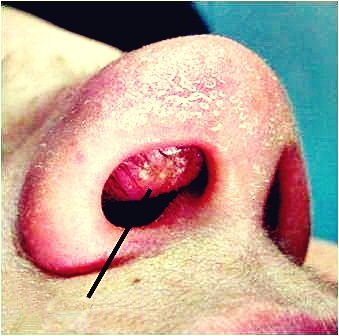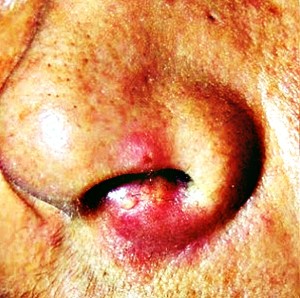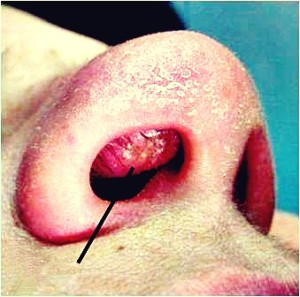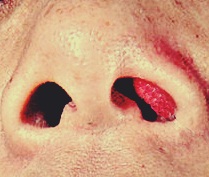It refers to the inflammation of tissues near nasal vestibule, which are around the opening of our nose. The infection is brought about by a bacterium known as Staphylococcus aureus. The condition causes an inflamed, red bump or a group of white or red bumps at the entrance of the nostril. The disorder can also occur due to viral infections such as upper respiratory tract infections. Chronic rhinorrhea and nose picking are other possible causes of the condition. Infections that occur around the entrance of the nose may cause pimples to develop at the foot of our nasal hairs. The pimples may later develop into crusts in the nostrils. An example of an infection with this effect is folliculitis.
Clinically, nasal vestibulitis is divided into chronic nasal vestibulitis and acute nasal vestibulitis. The symptoms of acute vestibulitis include tenderness, redness and swollen skin. On the other hand, someone with chronic vestibulitis would experience crusts and hardening of their vestibular skin. Antibiotics are used for treatment, and cleaning the crust is important where necessary. The crust is cleaned using a cotton applicator that is soaked in hydrogen peroxide. It would also be appropriate to use antibiotic steroid ointment. In cases of chronic fissures, cauterization is advisable.
If nasal vestibulitis is not properly treated, it can develop into more severe infections that could be accompanied by boils and furuncles. The infection could also spread to the patient’s brain through the veins leading to cavernous sinus thrombosis, a serious health condition that is life-threatening.
Causes
Nasal vestibule irritations could result in bacterial infection leading to the condition. The irritation could arise due to harmful dust, secretions of our nasal cavity, and skin injury as one picks the nose. There are many reasons that make the nasal tract, sinus lining and vestibules to discharge mucus. The major cause is usually viral bacterial infection that settle at the mucus lining of the nose leading to inflammation among other symptoms. Constant mucus discharge and inflammation of the nasal tract lining are at times made worse by a deviated septum making one of the nostrils completely blocked.
Nasal vestibulitis could also result due to various allergens in the surrounding. Some of the allergens include pollen, dust particles, chemicals like pesticides, house dust mites, and aerosol sprays among others. Additionally, the condition could arise when the body uses the nose to expel toxins that are not able to be released through the filter system in the kidney.
Diagnosis of nasal vestibulitis
Complete cooperation between the doctor and the patient is necessary in order to diagnose the disease. The health care provider will ask several questions that will help determine the cause of the situation and related symptoms. Some of the commonly asked questions in nasal vestibulitis diagnosis include;
- What medications an individual has been taking
- Has the individual been experiencing any bleeding or discharge from the nostrils
- Has the ability to smell been affected
- Is there any pain in the nose
- When did the symptoms that are being experienced begin.
Treatment of nasal vestibulitis
The patient should be given antibiotics for about seven to ten days. An example of an antibiotic that could be administered include Dicloxacillin. Antibiotic cream can also be applied on the infected area to ease the inflammation. An example of such a cream is Mupirocin and it should be applied two to three times in a day. If the problem persists or the infection reoccurs, the patient should be given another antibiotic known as Rifampin, which he or she should use two times in a day for four days. Rifampin kills the bacterium that causes the infection. In cases where an individual has a lump, it suggests that he or she could be having a deeper infection. The doctor makes a small cut on the lump and drains the pus. It is not advisable to drain out the pus at home as it could risk more infections. It should be done by qualified health providers.
Contagious
Nasal vestibulitis can be contagiuous depending on the cause of the illness. In most instances, the disease is not contagious but it can be passed from one person to another on few instances depending on the cause. Where the condition is contagious, doctors give advice on how the patient can reduce the chances of spreading it to other people.
There are various precautions that patients can take to ensure they reduce the risk of spreading the illness to others. Some of these include social distancing, vaccination, hand hygiene and use of masks.
Disinfecting hands using sanitizers or washing hands with soup and water greatly decreases the risk of contagion from nasal vassal vestibulitis caused by viral and bacterial infections. It is also advisable that if a person or his or her children are sick, they take time off from school or work and stay at home until the disease eases. A patient can wear a mask to reduce the chances of spreading the disease. The masks are available at pharmacies in a variety including those for children and others for adults.





